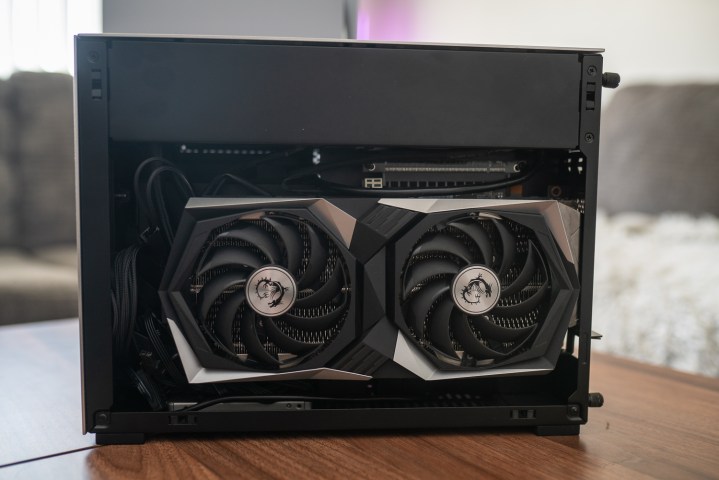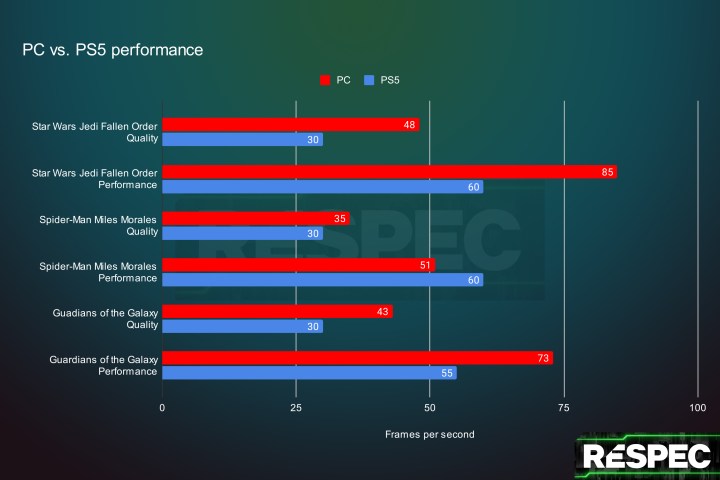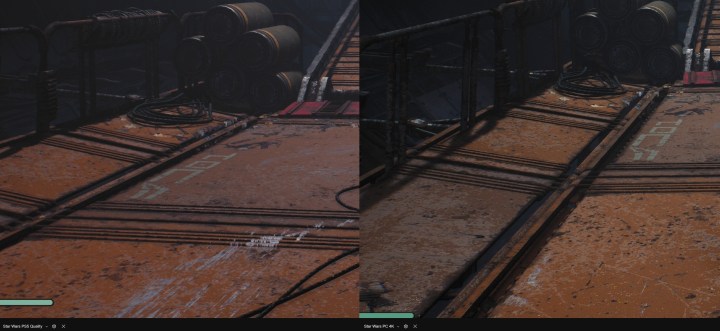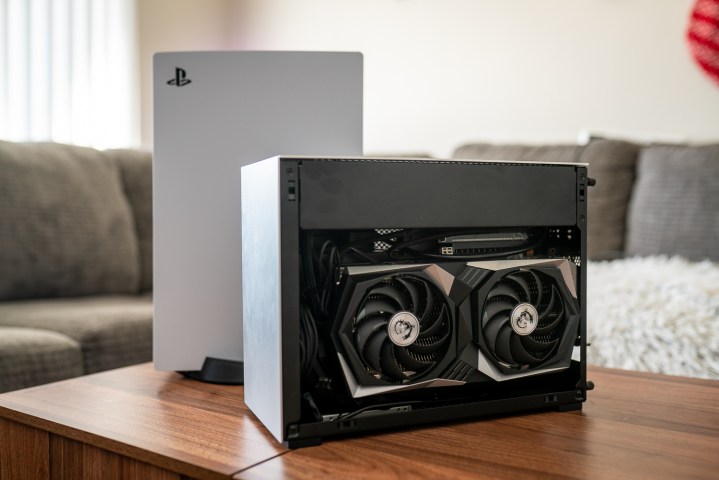
The PlayStation 5 is back in stock, and if you’ve been eagerly waiting to jump into the next generation of gaming, now seems like the time to strike. I’m here to sway you away from a console, though, because you can build a PC for around the same price that puts the PS5 to shame.
PC building is getting more expensive, but prices on the best graphics cards are dropping. With some clever shopping and bit of elbow grease, a gaming PC can deliver better performance and higher-quality visuals without costing much more than Sony’s console. Here’s the build you need.
Meet the PS5 killer

OK, before getting into the build, I need to lay some groundwork. The PS5 still has its place and consoles still serve a function that PCs can’t. If you’re set on the experience of Sony’s latest console, you should buy a PS5. Despite the ways it hasn’t lived up to its promises, even two years later, it’s hard to beat the value of a current-gen console. For everyone else, let me sway you toward a PC.
I set a budget of $600 for a couple of reasons. First and foremost, you can’t buy a PS5 for $500. There are PS5s readily available at online retailers, but only as a bundle for $560. This has been the case for several months, first with Call of Duty Modern Warfare 2, then with Horizon: Forbidden West, and now with God of War Ragnarök. I have no doubt that will continue.
Second is that you have a lot more leeway with a PC build. Shop for specific deals, cut some storage space down to save money, or increase the budget a bit for more power. In addition, spending a little extra over the PS5 nets a lot more performance.
Here’s the build I settled on:
- AMD Ryzen 5 3600 — $95
- Gigabyte B450M DS3H Wi-Fi — $80
- G.Skill Aegis 16GB (2 x 8GB) DDR4-3200 — $42
- Western Digital SN250 960GB NVMe SSD — $55
- ASRock RX 6600 XT Challenger D — $275
- Thermaltake Versa H17 — $50
- Thermaltake Smart Series 500W — $40
- Total — $637
I went overbudget a bit, but if you shop around (especially on secondhand marketplaces), you can easily shave $100 or more off the price. The main reason I went over was the RX 6600 XT. I had originally planned the build with an RX 6600, which is about $50 cheaper right now. The RX 6600 XT is significantly more powerful, though, so it’s worth the upcharge.
You’ll notice the PC I built doesn’t look quite the same as the build above, and that’s mainly just because of the components I had on hand. I’m using a different case, motherboard, and power supply, mainly due to the Lian Li A4-H20 PC case I used. This case, along with a properly sized power supply and motherboard, would easily add $300 to the price of the build. Thankfully, they don’t impact performance at all. They aren’t necessary upgrades.
For the build, I tried to match the PS5 as much as possible. The Ryzen 5 3600 provides six Zen 2 cores, while the PS5 offers eight Zen 2 cores. However, you can overclock the Ryzen 5 3600 with a single click, so I chose a motherboard that supports overclocking. If you pick up this build, keep in mind that the motherboard may need a BIOS update to support the CPU.
Similarly, the RX 6600 XT is an RDNA 2 graphics card with 32 compute units (CUs) aimed at matching the custom 36-CU RDNA 2 GPU of the PS5. That’s less power for the PC, but we have the benefit of dedicated VRAM and RAM, while the PS5 uses shared memory. Finally, I went with a 960GB PCIe SSD, which is slightly larger than the 825GB SSD available on the PS5.

To get the full console experience, there are a couple of small extras you should pick up, too. The 8BitDo Wireless USB Adapter 2 is much better than relying on Bluetooth for your controller, and a mini Bluetooth keyboard like the Rii X8 makes using a PC on the couch much easier.
Before getting into performance and image quality, I want to note once again that the PS5 is a great value, even two years after its release. You should buy one over building a PC if you just want a set-it-and-forget-it gaming box. The main advantage of building a PC is that you have access to a larger library of games, a system that you can use for much more outside of gaming, and the ability to easily boost your performance with an upgrade in the future.
Off-the-charts performance
The PS5 is a 4K gaming console, so I ran all of my tests at 4K (despite the fact that the RX 6600 XT isn’t really a 4K GPU). The little PC put up an impressive fight, though. I tested each game trying to simulate the Quality and Performance modes you find in PS5 games. For Quality, it was 4K with the highest graphics preset, no tricks. For Performance, I stuck with 4K and the highest graphics preset, but I turned to dynamic upscaling tools like AMD’s FidelityFX Super Resolution (FSR) to boost performance.
And the PS5 doesn’t look so hot by comparison. At native 4K where PS5 games cap out at 30 frames per second (fps), the PC is able to achieve between 35 fps and 50 fps. Similarly, the PC jumps ahead into the 70 fps to 80 fps territory with a bit of upscaling, while the PS5 mostly stays locked at 60.

The only exception is Marvel’s Spider-Man: Miles Morales. The dynamic resolution on the PS5 was able to maintain a smooth 60 fps, while the PC couldn’t quite hit that mark. That’s likely due to the processor in the PC, showing what a couple of extra cores can do in CPU-limited games.
Still, these tests actually favor the PS5, particularly in Performance mode. Star Wars Jedi: Fallen Order, for example, runs at 2,169 x 1,220 resolution in its Performance mode, while the PC version is attempting to hit 4K with dynamic resolution. Similarly, Guardians of the Galaxy‘s performance mode knocks the game down to 1080p and still dips below 60 fps in many scenes. I used FSR’s Quality mode, which renders the game at 1440p.
As mentioned, I ran all of my PC tests with the highest graphics preset as well. The PS5 is usually using custom settings to fine-tune performance, so you can get much higher performance with the PC if you tweak some graphics settings or lower your resolution. Due to the frame rate caps on the PS5, you don’t have the same option to go beyond the limits set by the different graphics modes.

The highest graphics preset has some advantages, though. In Guardians of the Galaxy, you can see that the PC is using much higher-resolution textures compared to the PS5’s Quality mode (pay attention to the metal sheets at the bottom). You can see something similar in Star Wars Jedi: Fallen Order, though the difference is less stark.

It’s not always a win for PC, though. Miles Morales is a prime example of a game optimized originally for Sony’s console where similar hardware on PC can’t match the PS5. The PC shines more in multiplatform releases where the developer doesn’t target a system so directly.
Are console killers back?

It’s no secret that building a PC is getting more expensive. Graphics cards like the RTX 4090 are pushing flagship prices to places they’ve never gone before, next-gen DDR5 memory is still much more expensive than DDR4, and high-quality, high-capacity power supplies that you need to run the latest hardware are pricey.
The classic console killer PC at around $400 to $500 is hard to achieve in 2023, but with some thrifty shopping, you can get close. This will be even easier to achieve a few years down the line when the PS5 starts to show its age more. My only hope is that when the eventual PS6 arrives, you’ll be able to build a PC around the same price, too.
This article is part of ReSpec – an ongoing biweekly column that includes discussions, advice, and in-depth reporting on the tech behind PC gaming.




